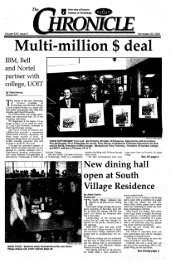Congratulations - Durham College and UOIT
Congratulations - Durham College and UOIT
Congratulations - Durham College and UOIT
You also want an ePaper? Increase the reach of your titles
YUMPU automatically turns print PDFs into web optimized ePapers that Google loves.
CAMPUS NEWS<br />
The Chronicle November 6, 2007 13<br />
It’s either your job or piercing<br />
Piercings<br />
or great job<br />
security?<br />
By Amy Gohr<br />
Chronicle Staff<br />
To some, piercing is viewed<br />
as melodramatic teen angst expressed<br />
through body mutilation.<br />
To others, it is a form of body modifi<br />
cation <strong>and</strong> personal expression.<br />
Regardless of the motive, many<br />
youth are compelled to puncture<br />
their fl esh with shiny, metal appendages.<br />
Th ere comes a time, however,<br />
when growing up <strong>and</strong> letting go<br />
of the pincushion obsession is no<br />
longer an option.<br />
Body modifi cation usually refers<br />
to the piercing of a part of the<br />
human body for the purpose of<br />
wearing jewelry in the opening<br />
created.<br />
In North America, common<br />
piercings include the earlobe, ear<br />
cartilage, eyebrow, tongue, lips,<br />
nose, navel, nipples <strong>and</strong> genitals.<br />
Yes, piercing hurts a little – I’ve<br />
had eight done, myself. Of course,<br />
having a one-inch titanium needle<br />
being shoved through skin or cartilage<br />
should be painful.<br />
Typically, the pierced area will<br />
swell <strong>and</strong> bleed slightly, but pain<br />
disappears after one or two days.<br />
After-care is important in ensuring<br />
that the piercing does not begin to<br />
drift (shift <strong>and</strong> heal in an unwanted<br />
position), become infected or<br />
rejected (forced out by the body<br />
through painful healing).<br />
According to a study conducted<br />
by Leger Marketing, nearly two<br />
out of 10 Canadians stated that<br />
they had body piercings, excluding<br />
traditional earrings.<br />
Of those, 85 per cent stated that<br />
their ears were pierced (i.e. cartilage)<br />
23 indicated that their navel<br />
had been pierced, <strong>and</strong> genital<br />
piercings ranked last, accounting<br />
for only one per cent.<br />
It should be noted that none of<br />
the respondents over the age of 55<br />
said they had any piercings on any<br />
part of the body other than their<br />
ears, <strong>and</strong> that 48 per cent were opposed<br />
to body piercing altogether.<br />
Also, among Canadians who do<br />
not have any body piercings, 30<br />
per cent are against the practice –<br />
53 per cent are not.<br />
Cultural ideas infl uence the<br />
types of piercing commonly done<br />
in diff erent parts of the world. For<br />
some, piercing is a religious, spiritual<br />
or ethnic experience; others<br />
choose to be pierced for ornamental,<br />
sexual or rebellious reasons.<br />
According to the American<br />
Museum of Natural History, “Ear,<br />
nose <strong>and</strong> lip ornaments as well as<br />
pierced fi gurines have been found<br />
in ancient burials of the Inca <strong>and</strong><br />
Moche of Peru, the Aztecs <strong>and</strong><br />
Maya of ancient Mexico <strong>and</strong> in<br />
graves of central Asian <strong>and</strong> Mediterranean<br />
peoples.”<br />
In these societies, the act of<br />
piercing is often part of a cere-<br />
‘<br />
You never have<br />
a second chance<br />
to make a fi rst impression.<br />
Barbara Hubert<br />
’<br />
mony marking a coming of age, a<br />
change in status or the accession<br />
to offi ce.<br />
Ornaments may be restricted<br />
to certain people or worn only on<br />
certain occasions.<br />
Because the jewelry can be<br />
made of precious <strong>and</strong> rare materials<br />
such as ivory, gold, jade or diamonds,<br />
they may signal privilege<br />
<strong>and</strong> wealth. Not in modern North<br />
America.<br />
Love them or hate them, the<br />
piercings have to go eventually.<br />
Most businesses require personal<br />
appearance to refl ect the company<br />
<strong>and</strong> conform to the status quo.<br />
Many people are ostracized if<br />
they choose to keep piercings in<br />
the workplace because they aren’t<br />
in compliance with business st<strong>and</strong>ards.<br />
Th ey want professional personal<br />
presentation, <strong>and</strong> individuality<br />
is generally stomped out in the<br />
case of piercings, not to mention<br />
hair colour <strong>and</strong> tattoos.<br />
At what point do workplace restrictions<br />
infringe upon personal<br />
rights <strong>and</strong> freedoms?<br />
“If you’re the kind of person<br />
who sees working in an offi ce for<br />
a faceless corporation as an aspiration,<br />
you don’t deserve to have<br />
piercings,” said Chris Dickey, a recent<br />
graduate of <strong>Durham</strong> <strong>College</strong>’s<br />
Multimedia Design program <strong>and</strong><br />
proud owner of eight piercings –<br />
most of which are typically inappropriate<br />
for work.<br />
Dickey added that although<br />
many employers will request removal<br />
of piercings, this is less common<br />
in artistic <strong>and</strong> newer-generation<br />
fi elds such as new media <strong>and</strong><br />
the music industry. On the whole,<br />
however, piercings <strong>and</strong> other body<br />
modifi cations are frowned upon<br />
in the workplace.<br />
So where does this leave the<br />
modern pincushion?<br />
Piercings are not a fashion<br />
trend or fad; they’ve been around<br />
for a long time <strong>and</strong> are not going<br />
anywhere soon.<br />
For some, however, retiring a<br />
piercing is inevitable. Whatever<br />
the initial reason for piercing, most<br />
people outgrow them – by choice<br />
or request.<br />
In a recent survey, career website<br />
Vault found that more than<br />
half of the business managers<br />
surveyed would be less likely to<br />
hire an applicant with visible body<br />
piercings, <strong>and</strong> 10 per cent had disciplined<br />
workers because of piercings.<br />
A job applicant’s appearance<br />
should be conservative, even at a<br />
casual company, says Barbara Hubert,<br />
director of career development<br />
at Chapman University.<br />
“You never have a second<br />
chance to make a fi rst impression.<br />
And interviews are serious events<br />
<strong>and</strong> should be taken seriously.”<br />
To be taken seriously in the<br />
business world today, you need<br />
to look the part. If you can’t distinguish<br />
your face <strong>and</strong> ears from a<br />
horrifi c torture scene in Saw III, it’s<br />
no wonder you can’t fi nd a job.<br />
Society <strong>and</strong> its norms will catch<br />
up with you eventually, whether<br />
you’re 20, 30 or 50. Lose the metal<br />
<strong>and</strong> just conform – consider the<br />
loss of your individuality an emotional<br />
piercing for life.















